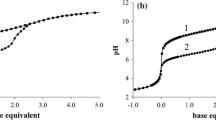Abstract
The dermatophyteMicrosporum gypseum was cultivated in media containing 0.5% cystine in suspension, and 0.05% peptone or 1% glucose and 0.05% peptone. During growth on cystine the excess sulphur was oxidized and excreted into the medium not only in the form of sulphate but also in the form of sulphite. Sulphite was produced especially during first phases of growth, where its quantity was higher than that of sulphate and its maximum concentration exceeded 1 mg/ml. /S-sulphocysteine, detected chromatographically and determined quantitatively, originated in large quantities by the reaction of sulphite with cystine in the medium. Both sulphite and (S-sulphocysteine were further oxidized to sulphate. After exhaustion of cystine 90 –93 % of the sulphur present was converted to sulphate in the cultivation medium.
Similar content being viewed by others
References
Archibald R. M., Reiss F.: Some biochemical implications from a study of growth of pathogenic fungi on media containing single amino acids.Ann. N.Y. Acad. Sci. 50, 1388 (1950).
Bailey J. L., Cole R. D.: Studies on the reaction of sulfite with proteins.J. Biol. Chem. 234, 1733 (1959).
Bayfield R. F., Clarke V., Cole E. R.: Selective test for organic sulfur compounds.J. Chromatog. 19, 370 (1965).
Bereston E. S., Robinson H., Williams S. A.: The quantitative nutritional requirements of the genus Microsporum.J. Invest. Dermatol. 30, 63 (1958).
Brenner M., Niederwieser A.: Dünnschicht-Chromatographie von Aminosäuren.Experientia 16, 378 (1960).
Chopra S. L.: A turbidimetric method for microdetermination of sulfur in proteins.Ind. J. Chem. 2, 18 (1964).
Clerivet A.: Étude des exigences nutritives duTrichophyton verrucosum (Bodin) et de son activité protéolytique et kératinolytiquein vitro. Thèse Doot. Sci. Nat. Fac. Sci., Toulouse 1971.
Dittrich H. H., Staudenmayer T.: Über die Zusammenhänge zwischen der Sulfit-Bildung und der Schwefelwasserstoff-Bildung beiSaccharomyces cerevisiae.Zbl. Bakt. II Orig. 124, 113 (1970).
Fujii T.: Biochemical studies on pathogenic fungi VI.Pharm. Bull. 5, 503 (1957).
Giblett E. R., Henry B. S.: Physiological studies on the genusMicrosporum.J. Invest. Deimatol. 14, 377 (1950).
Gunnison A. F., Palmes E. D.: Persistence of plasma S-sulfonates following exposure of rabbits to sulfite and sulfur dioxide.Toxicol. Appl. Pharmacol. 24, 266 (1973).
Horváth H.: Examinations on keratinophilic fungi.Ann. Univ. Budapest. Sec. Biol. 8, 107 (1966).
Kunert J.: Keratin decomposition by dermatophytes. I. Sulfite production as a possible way of substrate denaturation.Z. Allg. Mikrobiol. 13, 489 (1973).
Luchi P., de Marco C.: Thiosulfate production during transamination of S-sulfohomocysteine.Ital. J. Biochem. 18, 451 (1969).
Matsunaga I.: Cysteine-S-sulfonate formation from cystine by molds.Jap. J. Microbiol. 14, 508 (1970).
Milligan B., Swan J. M.: New syntheses of disulphides from Bunte salts.J. Chem. Soc. (London) 1962-11, 2172 (1962a).
Milligan B., Swan J. M.: Bunte salts (R.SSO3Na).Rev. Pure Appl. Chem. 12, 72 (1962b).
Ragot J.: Influence de la nutrition azotée sur la croissance, la sporulation et la morphologie duKeratinomyces ajelloi Vanbr.C.R. Soc. Biol. 160, 682 (1966a).
Ragot J.: Activité kératinolytique duKeratinomyces ajelloi Vanbr. sur la laine non denaturée.C.R. Acad. Sci. Paris Sér. D,262, 412 (1966b).
Ragot J.: Comportement duKeratinomyces ajelloi Vanbr. in vitro, son activité kératinolytique et protéolytique. Thèse Doct. Soi. Nat. Fac. Sci., Toulouse, 1968.
Ragot J.: Influence de certains agents de stérilisation sur la kératine.Mycopathol. Mycol. Appl. 39, 177 (1969).
Raubitschek F.: Organic sulphur and the keratinophilia of dermatophytes.Sabouraudia 2, 40 (1962).
Robbins W. J., Ma R.: Growth factors forTrichophyton mentagrophytes.Amer. J. Bot. 32, 509 (1945).
Roy A., Trudinger P.: The biochemistry of inorganic compounds of sulfur. Cambridge University Press, Cambridge 1970.
Saville B.: A scheme for the colorimetric determination of microgram amounts of thiols.Analyst 83, 670 (1958).
Schaper H. G., Ziegler H.: Untersuchungen über den Cystinstoffwechsel der Dermatophyten. Vortrag, 5. Tagung der Gesellschaft für Medizinische Mykologie der DDR, Leipzig 7. - 10. 5. 1970.
Schaper H. G., Ziegler H.: Untersuchungen zum Schwefelstoffwechsel der Dermatophyten. Abstrakta III. Symposium mycologicum, p. 21, Sczeczyn 22.–23. 9. 1972.
Stahl W. H., McQue B., Mandels G. R., Siu G. H.: Studies on the microbiological degradation of wool. I. Sulphur metabolism.Arch. Biochem. 20, 422 (1949).
Stockdale P. M.: Requirements for the growth and sporulation ofTrichophyton persicolor.J. Gen. Microbiol. 8, 434 (1953).
Stricks W., Kolthoff J. M.: Equilibrium constants of the reaction of sulfite with cystine and with dithiodiglycolic acid.J. Amer. Chem. Soc. 73, 4569 (1951).
West P. W., Gaeke G. C.: Fixation of sulfur dioxide as disulfitomercurate (II) and subsequent colorimetric estimation.Anal. Chem. 28, 1816 (1956).
Wolfram L. J., Bruggemans K.: Preparation and properties of hair containing Bunte salts residues.TGA Cosmet. J. 2, 45 (1970).
Ziegler H., Reichmann G.: Über den Schwefelstoffwechsel vonMicrosporum canis.Mykosen 11, 903 (1968).
Ziegler H., Böhme H., Reichmann G.: Stoffwechselphysiologische Untersuchungen über den Abbau von Proteinen durchMicrosporum gypseum undM. canis.Derm. Mschr. 155, 835 (1969).
Author information
Authors and Affiliations
Rights and permissions
About this article
Cite this article
Kunert, J. Formation of sulphate, sulphite and s-sulphocysteine by the fungusMicrosporum gypseum during growth on cystine. Folia Microbiol 20, 142–151 (1975). https://doi.org/10.1007/BF02876771
Received:
Issue Date:
DOI: https://doi.org/10.1007/BF02876771




